一:类的6个默认成员函数

二:构造函数
1.概念
观察下述代码:
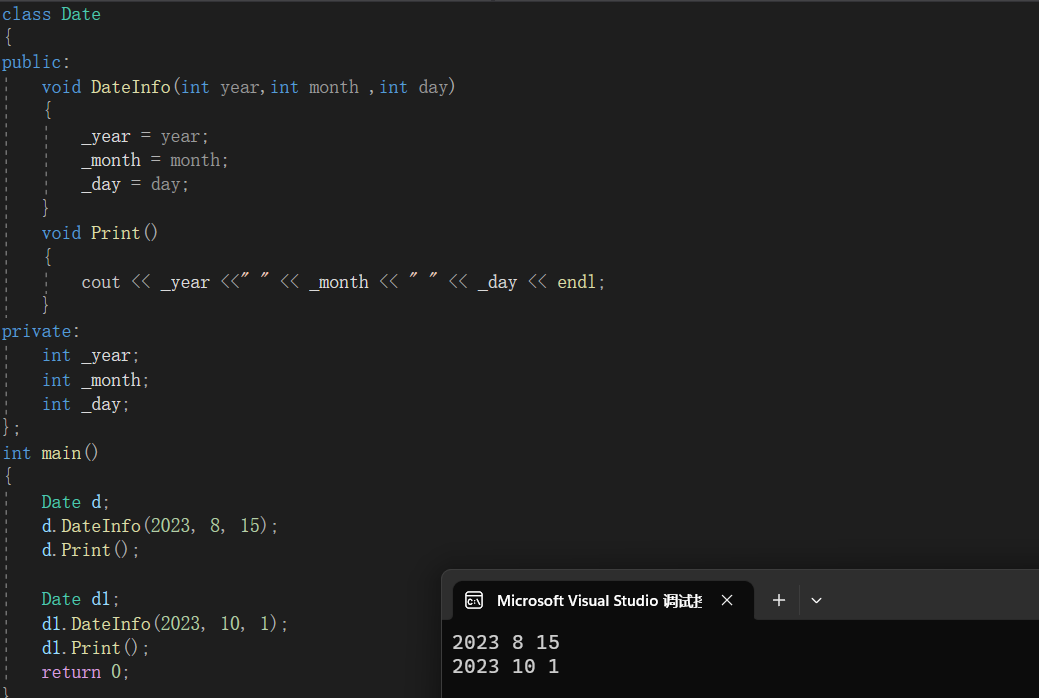
每创建一个新的 Date 类的对象都需要调用 DateInfo 函数,在创建对象个数少的时候没有什么问题,但当需要创建很多个对象的时候会很麻烦,所以C++规定我们可以在类里面写一个构造成员函数 ,不需要每次调用都初始化。
构造函数是一个特殊的成员函数,名字与类名相同,创建类类型对象时由编译器自动调用,以保证每个数据成员都有 一个合适的初始值,并且在对象整个生命周期内只调用一次。
2.特性
构造函数是特殊的成员函数,需要注意的是,构造函数虽然名称叫构造,但是构造函数的主要任务并不是开空间创建对象,而是初始化对象。
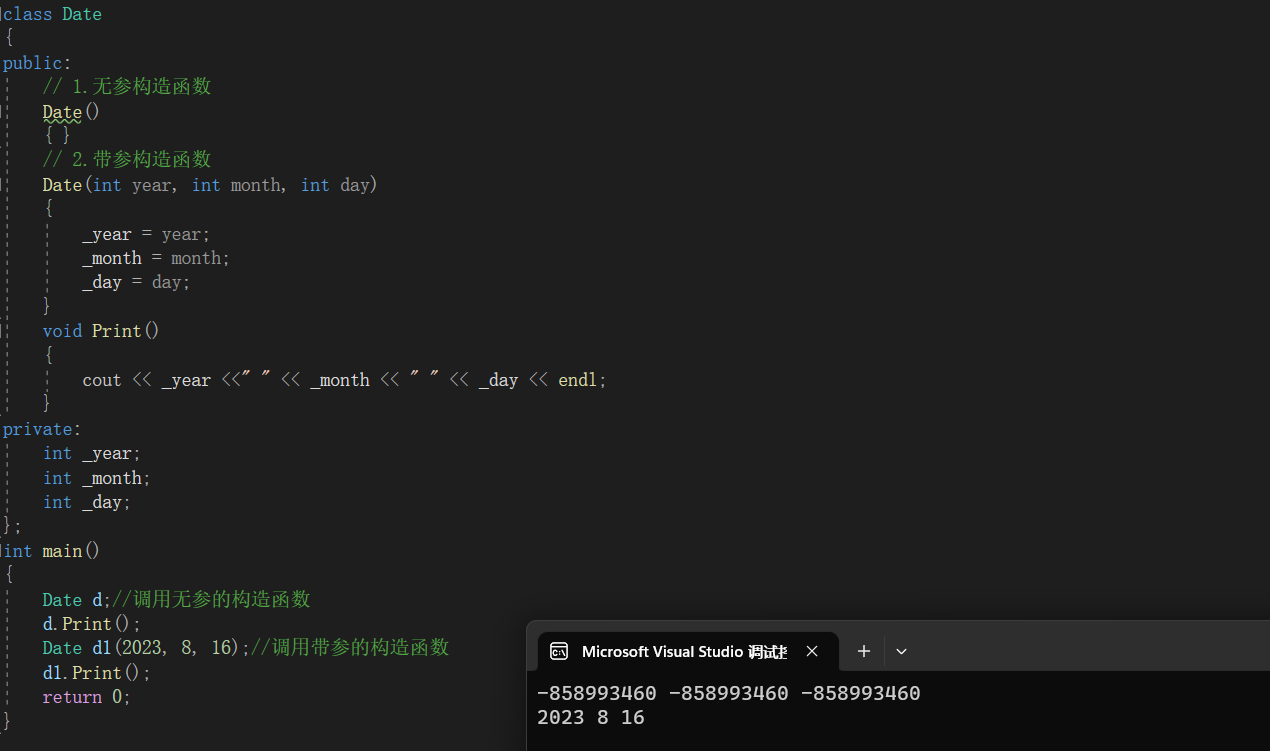
注意:如果通过无参构造函数创建对象时,对象后面不用跟括号,否则就成了函数声明
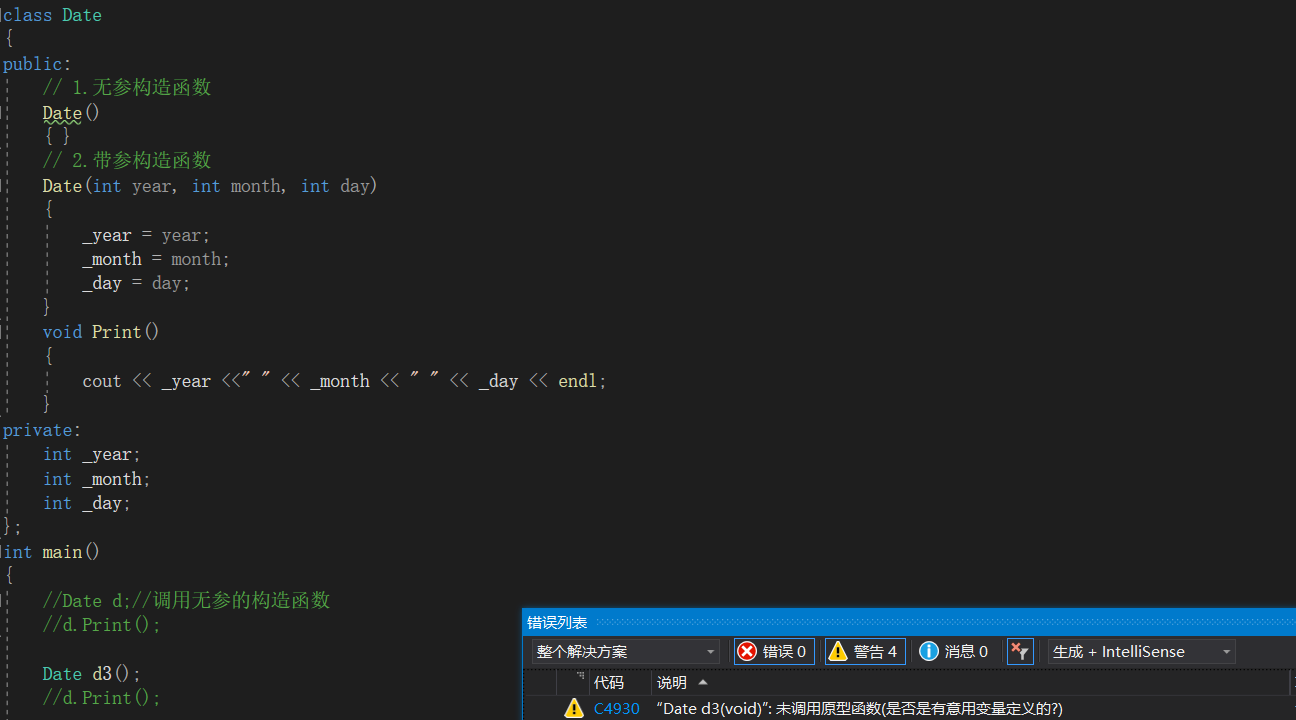
类中没有显 式定义构造函数:
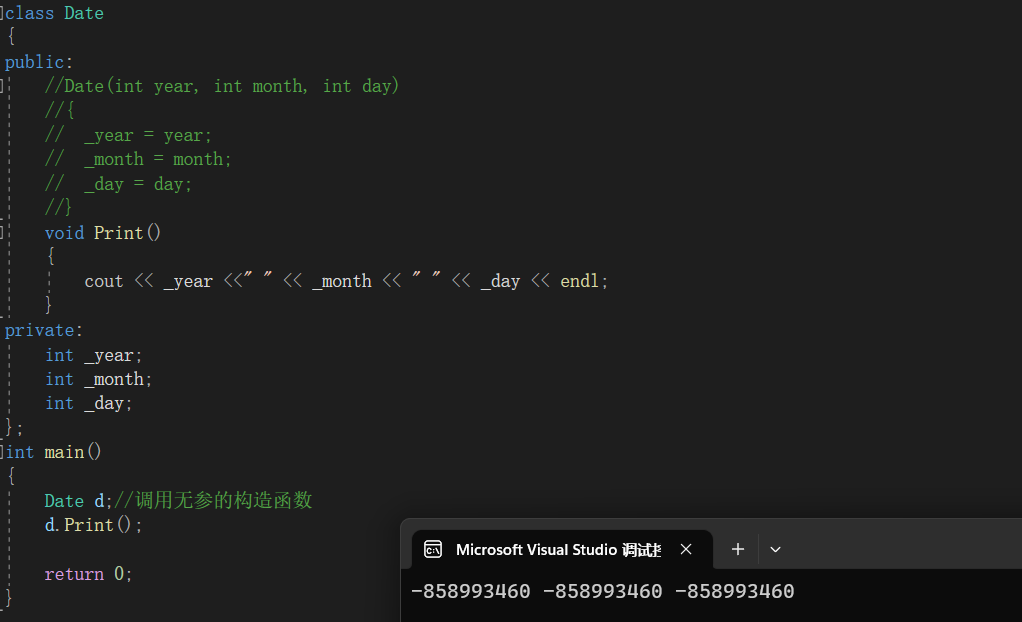
类中有显式定义构造函数:

<6>.C++把类型分成内置类型(基本类型)和自定义类型。内置类型就是语言提供的数据类型,如:int/char/指针类型...,自定义类型就是我们使用class/struct/union等自己定义的类型,看看下面的程序,就会发现编译器生成默认的构造函数会对自定类型成员_t调用的它的默认构造函数。
#include<iostream>
using namespace std;
class Time
{
public:
Time()
{
cout << "Time()" << endl;
_hour = 0;
_minute = 0;
_second = 0;
}
private:
int _hour;
int _minute;
int _second;
};
class Date
{
public:
//void Print()
//{
// cout << _year <<" " << _month << " " << _day << endl;
//}
private:
//内置类型
int _year;
int _month;
int _day;
// 自定义类型
Time _t;
};
int main()
{
Date d;
//d.Print();
return 0;
}程序运行结果为:
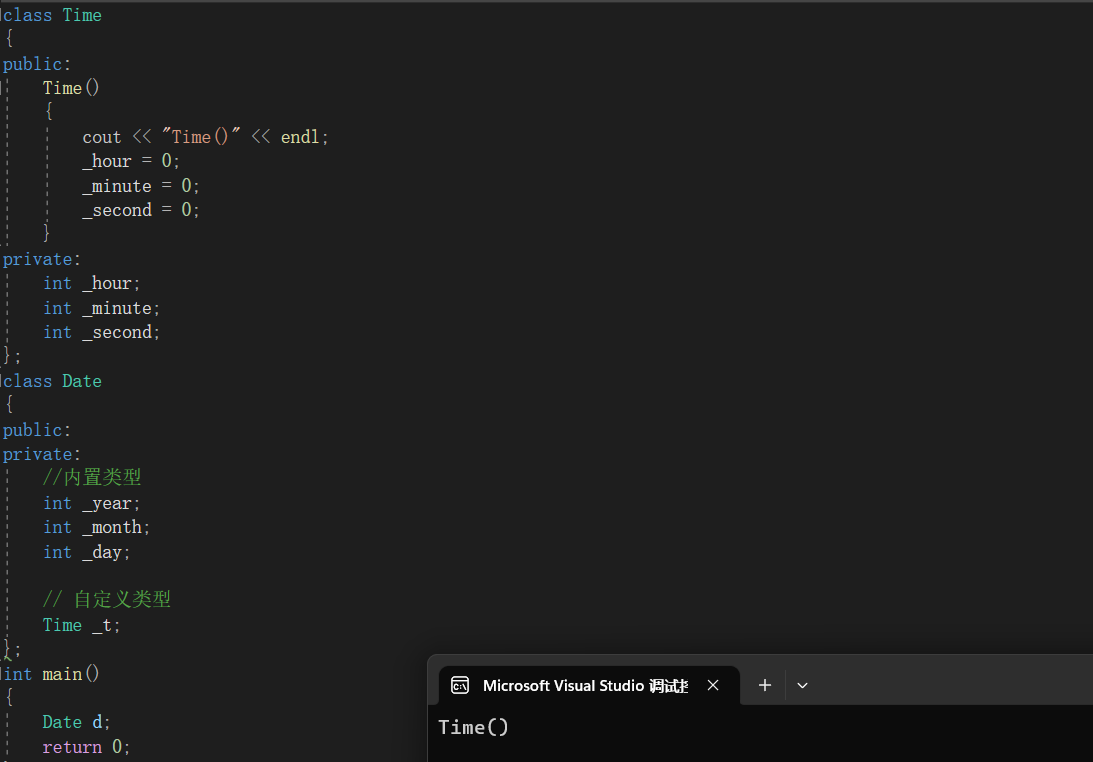
C++11,声明给缺省值,默认使用缺省值:
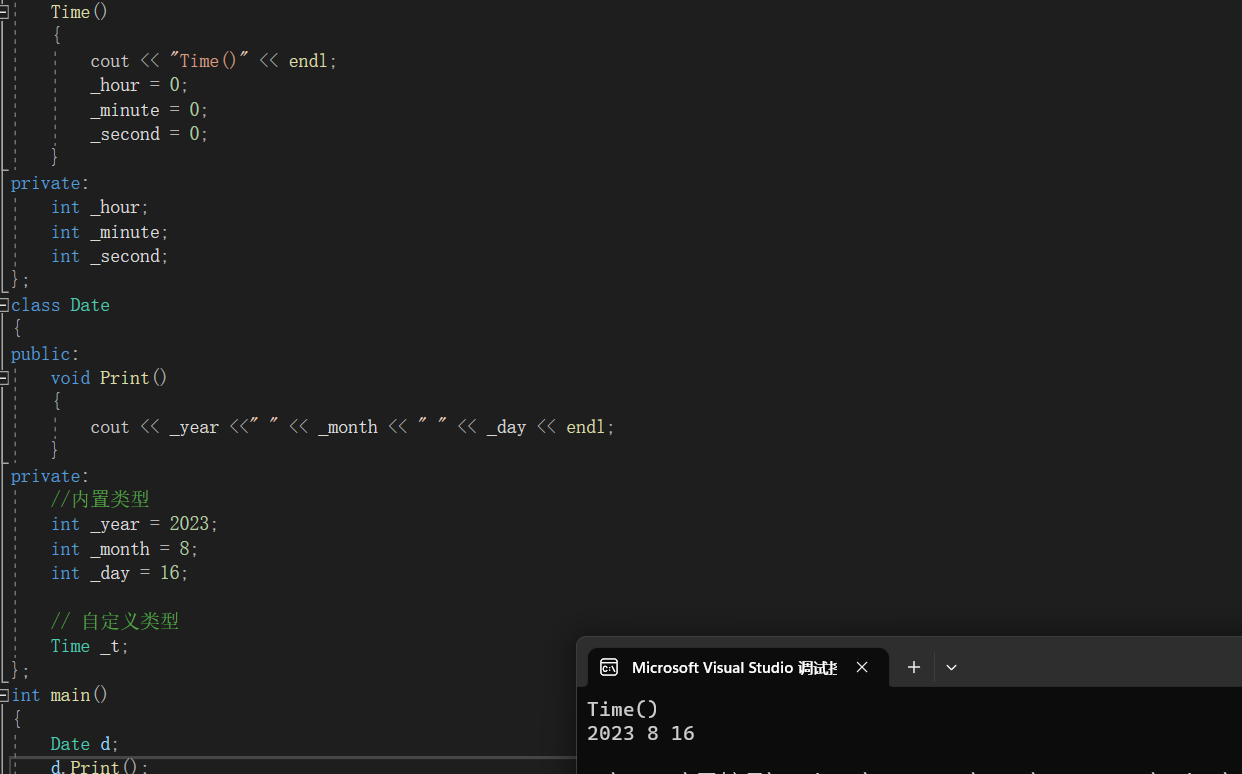
总结:
构造函数,也是默认成员函数,我们不写,编译器会自动生成。
编译器生成的默认构造函数的特点:
<1>: 我们不写才会生成,我们写了就不会生成(任何一个)
<2>: 内置类型的成员不会处理(有些编译器会处理,但很少)
<3>: 自定义类型的成员才会处理,回去调用这个成员的(默认)构造函数
一般情况下,都需要我们自己写构造函数,决定初始化的方式。
特殊情况:成员变量全是自定义类型,可以考虑不写构造函数。

三:析构函数
1.概念
析构函数:与构造函数功能相反,析构函数不是完成对对象本身的销毁,局部对象销毁工作是由编译器完成的。而 对象在销毁时会自动调用析构函数,完成对象中资源的清理工作。
2.特性
#include<iostream>
#include<assert.h>
using namespace std;
typedef int DateType;
class Stack
{
public:
Stack(size_t capacity = 4)//栈初始化
{
if (capacity == 0)
{
_a = nullptr;
_size = _capacity = 0;
}
else
{
_a = (DateType*)malloc(sizeof(DateType) * capacity);
if (_a == nullptr)
{
perror(" malloc fail ");
return;
}
_capacity = capacity;
_size = 0;
}
}
void Push(DateType x)//入栈
{
if (_size == _capacity)//扩容
{
size_t newcapacity = _capacity == 0 ? 4 : _capacity * 2;
DateType* tmp = (DateType*)realloc(_a, sizeof(DateType) * newcapacity);
if (tmp == nullptr)
{
perror(" realloc fail ");
return;
}
if (tmp == _a)
{
cout << _capacity << "原地扩容" << endl;
}
else
{
cout << _capacity << "异地扩容" << endl;
}
_a = tmp;
_capacity = newcapacity;
}
_a[_size] = x;
_size++;
}
int Top()//栈顶元素
{
return _a[_size - 1];
}
void Pop()//出栈
{
assert(_size > 0);
_size--;
}
bool StackEmpty()//判断栈内是否为空
{
return _size == 0;
}
~Stack()//析构
{
cout << " ~Stack() " << endl;
if (_a)
{
free(_a);
_a = nullptr;
_size = _capacity = 0;
}
}
private:
DateType* _a;
int _size;
int _capacity;
};测试用例及其运行结果:
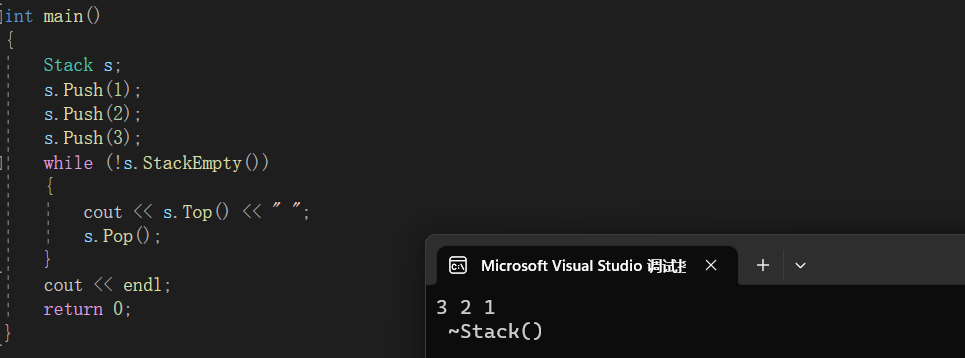
我们发现,程序自动调用了析构函数。
<5>.编译器生成的默认析构函数,对自定类型成员调用它的析构函数。
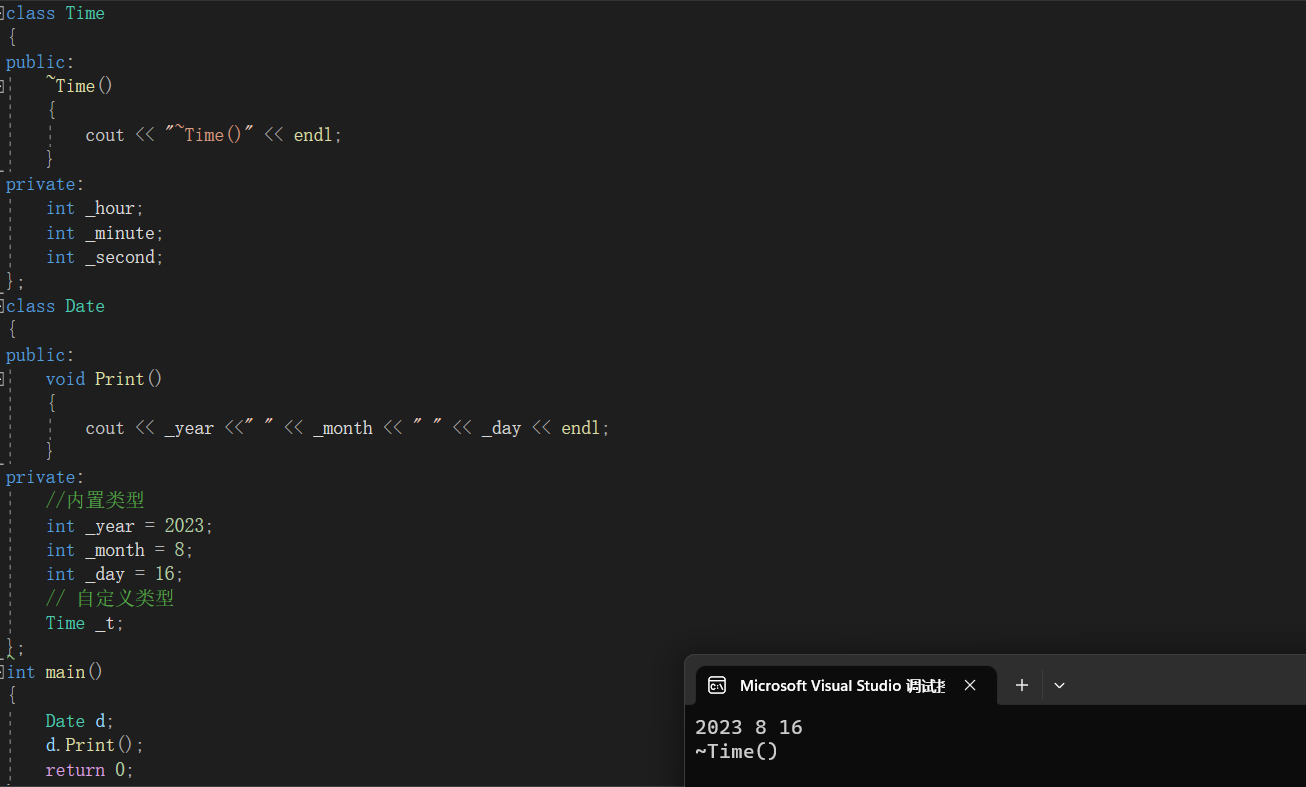
在main方法中根本没有直接创建Time类的对象,为什么最后会调用Time类的析构函数?
原因:在main函数中创建了Date对象d,而d中包含4个成员变量,其中_year, _month, _day三个是
内置类型成员,销毁时不需要资源清理,最后系统直接将其内存回收即可;而_t是Time类对象,所以在d销毁时,要将其内部包含的Time类的_t对象销毁,所以要调用Time类的析构函数。但是main函数中不能直接调用Time类的析构函数,实际要释放的是Date类对象,所以编译器会调用Date类的析构函数,而Date没有显式提供,则编译器会给Date类生成一个默认的析构函数,目的是在其内部调用Time类的析构函数,即当Date对象销毁时,要保证其内部每个自定义对象都可以正确销毁main函数中并没有直接调用Time类析构函数,而是显式调用编译器为Date类生成的默认析构函数。
注意:创建哪个类的对象则调用该类的析构函数,销毁那个类的对象则调用该类的析构函数
内置类型的成员,不做处理
自定义类型的成员,会去调用它的析构
<6>.如果类中没有申请资源时,析构函数可以不写,直接使用编译器生成的默认析构函数,比如Date类;有资源申请时,一定要写,否则会造成资源泄漏,比如Stack类。
四: 拷贝构造函数
1.概念

解决方法:
引用,别名改变会影响原序列改变。
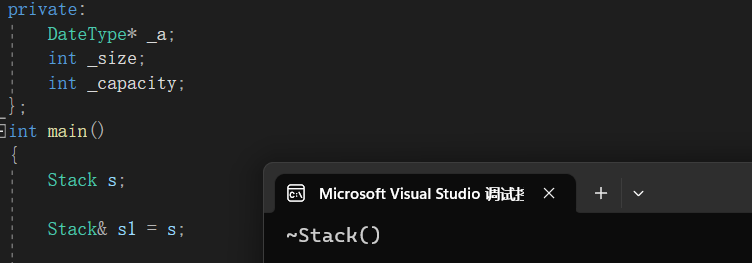
拷贝构造函数概念:
只有单个形参,该形参是对本类类型对象的引用(一般常用const修饰),在用已存
在的类类型对象创建新对象时由编译器自动调用。一个对象不会析构两次。(后续进行解释原因)
2.特性
#include<iostream>
using namespace std;
class Date
{
public:
Date(int year = 2023, int month = 8, int day = 16)
{
_year = year;
_month = month;
_day = day;
}
void Print()
{
cout << _year <<" " << _month << " " << _day << endl;
}
Date(const Date& d)
{
_year = d._year;
_month = d._month;
_day = d._day;
}
private:
//内置类型
int _year = 2023;
int _month = 8;
int _day = 16;
};
int main()
{
Date d;
d.Print();
Date d1(d);
d1.Print();
return 0;
}
class Time
{
public:
Time(int hour = 0, int minute = 0,int second = 0)//构造函数 --- 初始化对象
{
_hour = hour;
_minute = minute;
_second = second;
}
Time(const Time& t)
{
cout << " Time(const Time& t) " << endl;
_hour = t._hour;
_minute = t._minute;
_second = t._second;
}
~Time()
{
cout << "~Time()" << endl;
}
private:
int _hour;
int _minute;
int _second;
};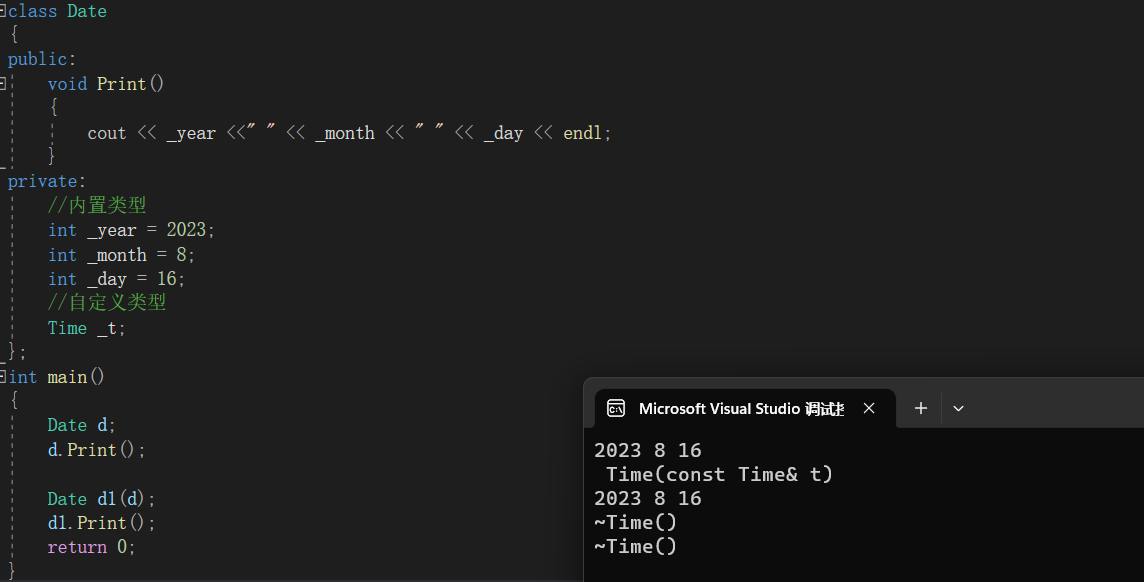
我们不写,编译器默认生成拷贝构造函数跟之前的构造函数特性不一样:
*1.内置类型,值拷贝
*2.自定义类型,调用它的拷贝构造函数
Date 不需要我们实现拷贝构造,默认生成的就可以使用
Stack 需要我们自己实现深拷贝的拷贝构造,默认生成的会出问题。
Stack示例
*调用默认生成的构造函数:

我们发现程序运行出错,接下来我们对程序进行调试,逐步观察:

创建对象 s ,入栈,都没有问题。接下来使用系统的默认的拷贝构造函数,将 s 拷贝给 s1 :

我们可以看到,拷贝过程没有问题,接下来,调用在程序结束前,默认调用的析构函数(在此处相当栈的销毁 --- Destory 函数):
 第一次调用析构函数
第一次调用析构函数
 没有问题,对象s1成功销毁,空间被释放。
没有问题,对象s1成功销毁,空间被释放。 第二次调用析构函数
第二次调用析构函数

我们发现,在释放 _a 空间的时候,程序报错 --- 原因:s 和 s1 指向同一空间,在调用 s1 的析构函数时,已经将 _a 的空间释放掉了,而在调用 s 的析构函数的时候,再一次的对 _a 空间进行了释放。一块内存空间进行多次释放,必然造成程序的崩溃。
*调用自己写的拷贝构造函数:
#include<iostream>
#include<assert.h>
#include<stdlib.h>
using namespace std;
typedef int DateType;
class Stack
{
public:
Stack(size_t capacity = 4)//栈初始化
{
if (capacity == 0)
{
_a = nullptr;
_size = _capacity = 0;
}
else
{
_a = (DateType*)malloc(sizeof(DateType) * capacity);
if (_a == nullptr)
{
perror(" malloc fail ");
return;
}
_capacity = capacity;
_size = 0;
}
}
void Push(DateType x)//入栈
{
if (_size == _capacity)//扩容
{
size_t newcapacity = _capacity == 0 ? 4 : _capacity * 2;
DateType* tmp = (DateType*)realloc(_a, sizeof(DateType) * newcapacity);
if (tmp == nullptr)
{
perror(" realloc fail ");
return;
}
if (tmp == _a)
{
cout << _capacity << "原地扩容" << endl;
}
else
{
cout << _capacity << "异地扩容" << endl;
}
_a = tmp;
_capacity = newcapacity;
}
_a[_size] = x;
_size++;
}
int Top()//栈顶元素
{
return _a[_size - 1];
}
void Pop()//出栈
{
assert(_size > 0);
_size--;
}
bool StackEmpty()//判断栈内是否为空
{
return _size == 0;
}
~Stack()//析构
{
cout << " ~Stack() " << endl;
if (_a)
{
free(_a);
_a = nullptr;
_size = _capacity = 0;
}
}
Stack(const Stack& s)
{
cout << " Stack(const Stack& s) " << endl;
_a = (DateType*)malloc(sizeof(DateType) * s._capacity);
if (_a == nullptr)
{
perror("Stack malloc fail");
return;
}
memcpy(_a, s._a, sizeof(DateType) * s._size);
_size = s._size;
_capacity = s._capacity;
}
private:
DateType* _a;
int _size;
int _capacity;
};
int main()
{
Stack s;
Stack s1(s);
return 0;
}
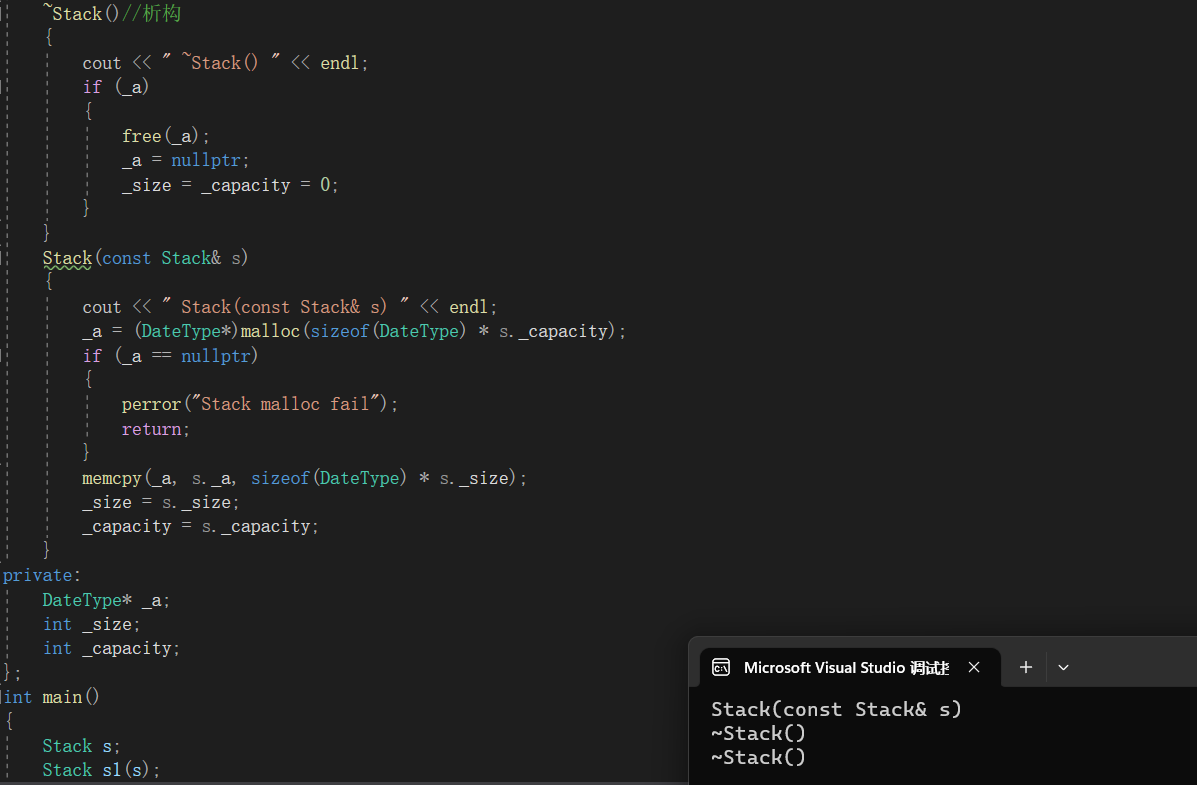
注意:类中如果没有涉及资源申请时,拷贝构造函数是否写都可以;一旦涉及到资源申请
时,则拷贝构造函数是一定要写的,否则就是浅拷贝。
五:赋值运算符重载
1.运算符重载
C++为了增强代码的可读性引入了运算符重载,运算符重载是具有特殊函数名的函数,也具有其返回值类型,函数名字以及参数列表,其返回值类型与参数列表与普通的函数类似。函数名字为:关键字operator后面接需要重载的运算符符号。函数原型:返回值类型 operator操作符(参数列表)注意:不能通过连接其他符号来创建新的操作符:比如operator@重载操作符必须有一个类类型参数用于内置类型的运算符,其含义不能改变,例如:内置的整型+,不 能改变其含义作为类成员函数重载时,其形参看起来比操作数数目少1,因为成员函数的第一个参数为隐藏的this.* :: sizeof ?: . 注意以上5个运算符不能重载。不能改变操作数的操作数个数,一个操作符十几个操作数,那么重载的时候九有几个参数
示例:日期类比较大小
在此处为了便于观察,我们将其分成 .h .c 文件
判断一个日期是否小于另一个日期 ,即重载运算符 <
// <运算符重载
bool Date::operator< (const Date& d)
{
if (_year < d._year)
{
return true;
}
else if (_year == d._year && _month < d._month)
{
return true;
}
else if (_year == d._year && _month == d._month && _day < d._day)
{
return true;
}
else
{
return false;
}
}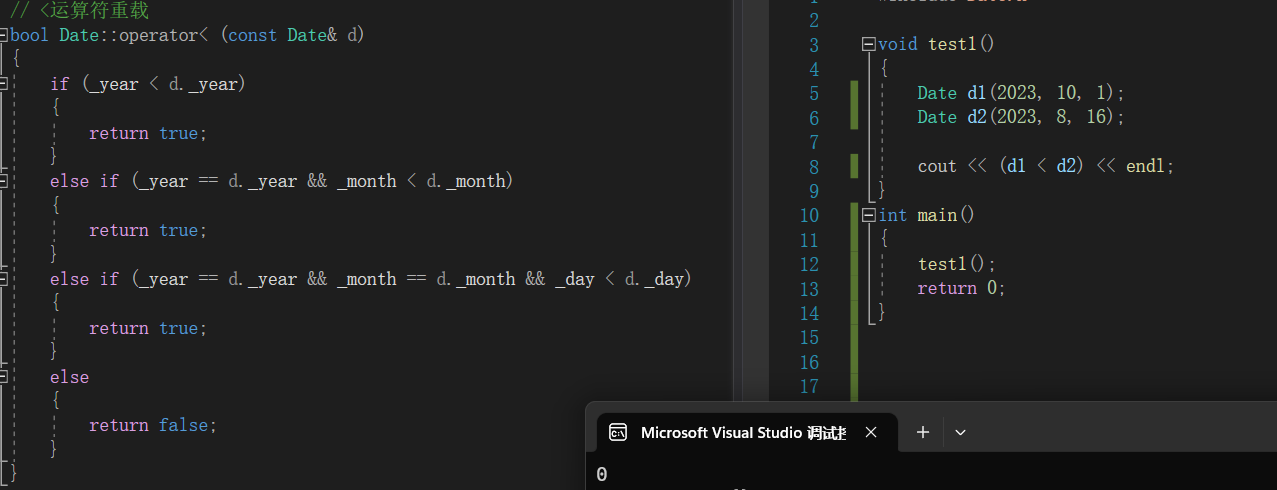
重载运算符 ==
// ==运算符重载
bool Date::operator== (const Date& d)
{
return _year == d._year && _month == d._month && _day == d._day;
}
重载 <=
// <=运算符重载
bool Date::operator <= (const Date& d)
{
return *this < d || *this == d;
}
重载 >
// >运算符重载
bool Date::operator>(const Date& d)
{
return !(*this <= d);
}
重载 !=
// !=运算符重载
bool Date::operator != (const Date& d)
{
return !(*this == d);
}
重载 >=
// >=运算符重载
bool Date::operator >= (const Date& d)
{
return *this > d || *this == d;
}

将其写在同一个文件中为(可以修改测试用例):
#include<iostream>
using namespace std;
class Date
{
public:
// 获取某年某月的天数
int GetMonthDay(int year, int month);
// 全缺省的构造函数
Date(int year = 1900, int month = 1, int day = 1);
// <运算符重载
bool operator < (const Date& d);
// ==运算符重载
bool operator==(const Date& d);
// <=运算符重载
bool operator <= (const Date& d);
// >运算符重载
bool operator>(const Date& d);
// >=运算符重载
bool operator >= (const Date& d);
// !=运算符重载
bool operator != (const Date& d);
// 析构函数
~Date();
private:
int _year;
int _month;
int _day;
};
//获取某年某月有多少天
int Date::GetMonthDay(int year, int month)
{
int arr[13] = { 0,31,28,31,30,31,30,31,31,30,31,30,31 };
// 0 1 2 3 4 5 6 7 8 9 10 11 12
if ((month == 2) && ((year % 4 == 0) && (year % 100 != 0) || (year % 400 == 0)))
{
arr[2] = 29;
}
return arr[month];
}
// 全缺省的构造函数
// ??? 把后面的参数去掉了?
Date::Date(int year, int month, int day)
{
_year = year;
_month = month;
_day = day;
//检查日期的合法性
if (month < 1 || month > 12 || day < 0 || day > GetMonthDay(year, month))
{
cout << "日期不合法" << endl;
}
}
//析构函数
//对象在销毁时会自动调用的函数析构函数,完成对象中资源的清理工作。
Date::~Date()
{
cout << "Date::~Date()" << endl;
}
// <运算符重载
bool Date::operator< (const Date& d)
{
if (_year < d._year)
{
return true;
}
else if (_year == d._year && _month < d._month)
{
return true;
}
else if (_year == d._year && _month == d._month && _day < d._day)
{
return true;
}
else
{
return false;
}
}
// ==运算符重载
bool Date::operator== (const Date& d)
{
return _year == d._year && _month == d._month && _day == d._day;
}
// <=运算符重载
bool Date::operator <= (const Date& d)
{
return *this < d || *this == d;
}
// >运算符重载
bool Date::operator>(const Date& d)
{
return !(*this <= d);
}
// >=运算符重载
bool Date::operator >= (const Date& d)
{
return *this > d || *this == d;
}
// !=运算符重载
bool Date::operator != (const Date& d)
{
return !(*this == d);
}
void test1()
{
Date d1(2023, 10, 1);
Date d2(2023, 8, 16);
cout << (d1 < d2) << endl;
}
int main()
{
test1();
return 0;
}2.赋值运算符重载
<1>. 赋值运算符重载格式
#include<iostream>
using namespace std;
class Date
{
public:
Date(int year = 2023, int month = 8, int day = 16)
{
_year = year;
_month = month;
_day = day;
}
void Print()
{
cout << _year <<" " << _month << " " << _day << endl;
}
Date(const Date& d)//拷贝构造
{
_year = d._year;
_month = d._month;
_day = d._day;
}
Date& operator=(const Date& d)//赋值运算符重载
{
if (this != &d)
{
_year = d._year;
_month = d._month;
_day = d._day;
}
return *this;
}
private:
//内置类型
int _year = 2023;
int _month = 8;
int _day = 16;
};
<2>. 赋值运算符只能重载成类的成员函数不能重载成全局函数
我们将赋值运算符从类中拿到全局里面:
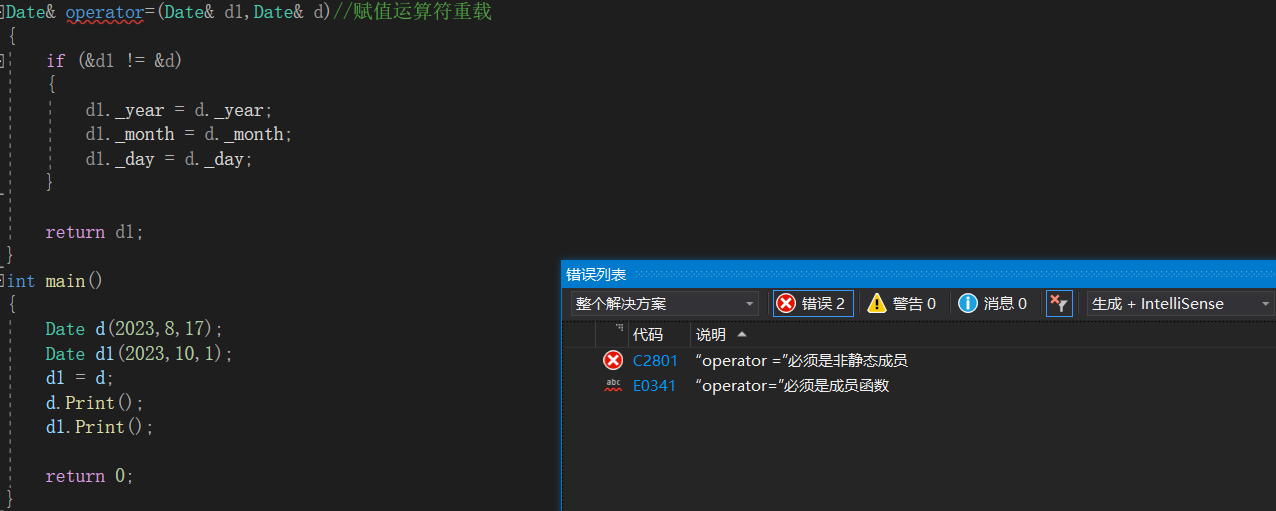
原因:赋值运算符如果不显式实现,编译器会生成一个默认的。此时用户再在类外自己实现
一个全局的赋值运算符重载,就和编译器在类中生成的默认赋值运算符重载冲突了,故赋值运算符重载只能是类的成员函数。
<3>. 用户没有显式实现时,编译器会生成一个默认赋值运算符重载,以值的方式逐字节拷贝。
内置类型成员变量是直接赋值的,而自定义类型成员变量需要调用对应类的赋值运算符重载完成赋值。
#include<iostream>
using namespace std;
class Time
{
public:
Time(int hour = 0, int minute = 0, int second = 0)
{
_hour = hour;
_minute = minute;
_second = second;
}
Time& operator=(const Time& t)
{
cout << " Time& operator=(const Time& t) " << endl;
if (this != &t)
{
_hour = t._hour;
_minute = t._minute;
_second = t._second;
}
return *this;
}
private:
int _hour;
int _minute;
int _second;
};
class Date
{
private:
//内置类型
int _year = 1970;
int _month = 1;
int _day = 1;
// 自定义类型
Time _t;
};既然编译器生成的默认赋值运算符重载函数已经可以完成字节序的值拷贝了,还需要自己实
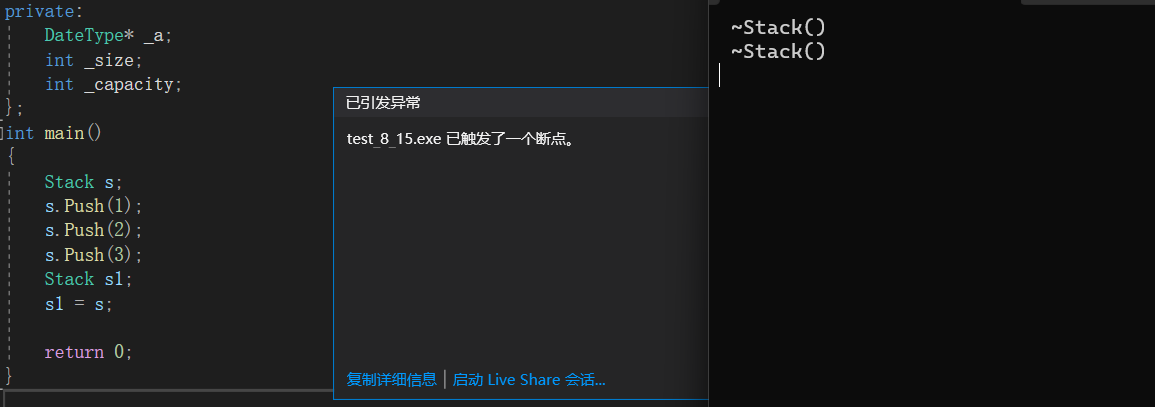
<4>.前(后)置++,前(后)置-- 重载
日期类:在写前(后)置++ 或前(后)置-- 时,我们需要得出 日期加天数 和 日期减天数
而日期加天数又分为原来的数据不变,和原来的数据改变两种状态,我们可以将其看作 加法 和 加等两种状态。
在此处,我们可以选择优先实现 += ,在实现日期加天数的时候,复用 +=
实现思路,日期加天数可能产生进位,此时我们需要知道每年每月对应 的天数,在此处我们可以写一个 GetMonthDay 的函数 --- 用于获取对应的天数。
// 获取某年某月的天数
int GetMonthDay(int year, int month)
{
int arr[13] = { 0,31,28,31,30,31,30,31,31,30,31,30,31 };
// 0 1 2 3 4 5 6 7 8 9 10 11 12
if ((month == 2) && ((year % 4 == 0) && (year % 100 != 0) || (year % 400 == 0)))
{
arr[2] = 29;
}
return arr[month];
}然后计算 日期+天数 为多少天,判断其是否大于对应年月的天数,如果小于可以直接返回日期(此时对应的天已经修改完成);如果大于,则用 加好后的天数 - 对应年月的天数 ,然后需要将月份 +1,判断月份是否等于13,若月份等于13,则需要将年份 +1 。具体代码如下:
// 日期+=天数
Date& operator+=(int day)
// 日期+=天数
//自己本身改变
{
//考虑加上的值为负数
if (day < 0)
{
return *this -= (-day);
}
_day += day;
/*int tmp = _day + day;*/ // 错误的 _day 的数值没有改变
while (_day > GetMonthDay(_year, _month))
{
_day -= GetMonthDay(_year, _month);
_month++;
if (_month == 13)
{
_year++;
//需要将月份重置
_month = 1;
}
}
return *this;
}在此处,我们可以先屏蔽掉 加上一个负数部分的代码,因为我们还没有写 -=。
输入测试用例:


检验此处结果是否正确:

我们发现结果无误。
日期 + 天数
在此种情况下,原来的日期并没有改变,我们可以复用 +=
原来的日期没有改变,需要提前记录下 *this ,修改记录的值,不影响 *this 的值。
代码为:
// 日期+天数
//自己本身没有改变,需要提前记录该值
Date operator+(int day)
{
Date tmp(*this);
tmp += day;// * 本身为*this ,改变tmp的值,*this的值不改变
return tmp;
}输入测试用例:
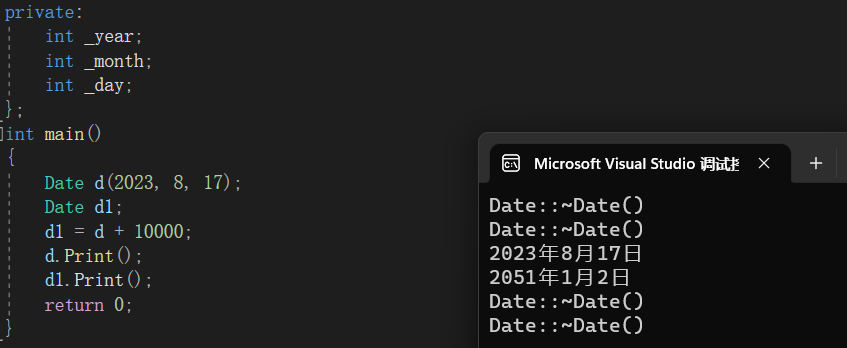

前(后)置++,前(后)置-- 重载
*前置++和后置++都是一元运算符,为了让前置++与后置++形成能正确重载。*C++规定:后置++重载时多增加一个int类型的参数,但调用函数时该参数不用传递,编译器自动传递 。*注意:后置++是先使用后+1,因此需要返回+1之前的旧值,故需在实现时需要先将this保存一份,然后给this+1
// 前置++
Date& operator++()
{
*this += 1;
return *this;//出作用域,this 还在 &
}
// 后置++
Date operator++(int)
{
Date tmp(*this);
*this += 1;
return tmp;//出作用域,tmp 不在 无需&
}
// 后置--
Date operator--(int)
{
Date tmp(*this);
*this -= 1;
return tmp;
}
// 前置--
Date& operator--()
{
*this -= 1;
return *this;
}输入测试用例:
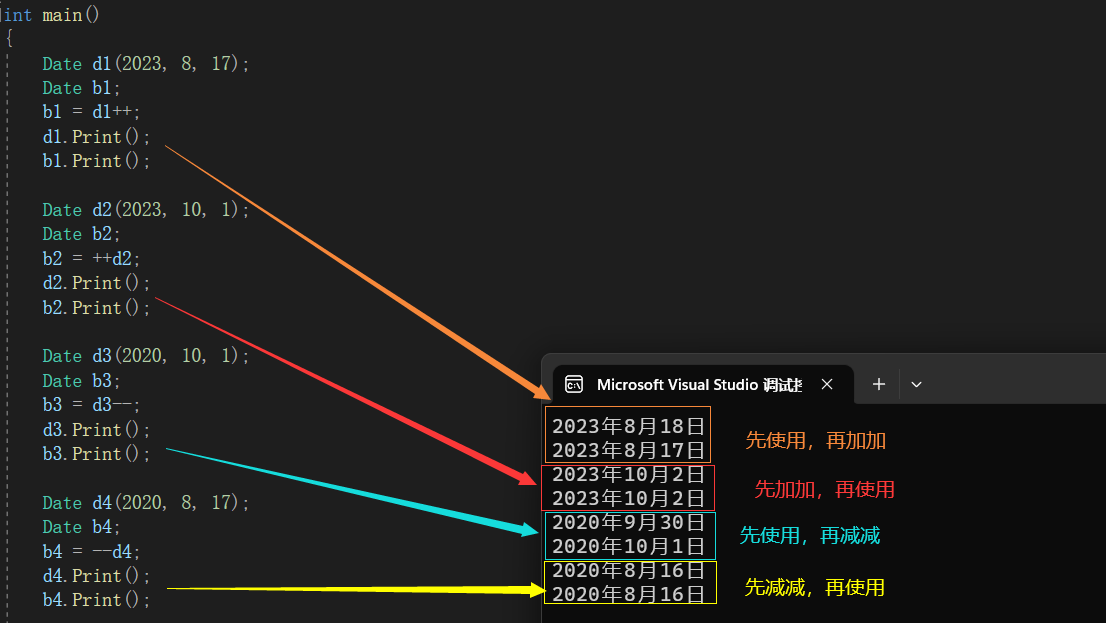
六:const 成员
将const修饰的“成员函数”称之为const成员函数,const修饰类成员函数,实际修饰该成员函数隐含的this指针,表明在该成员函数中不能对类的任何成员进行修改。
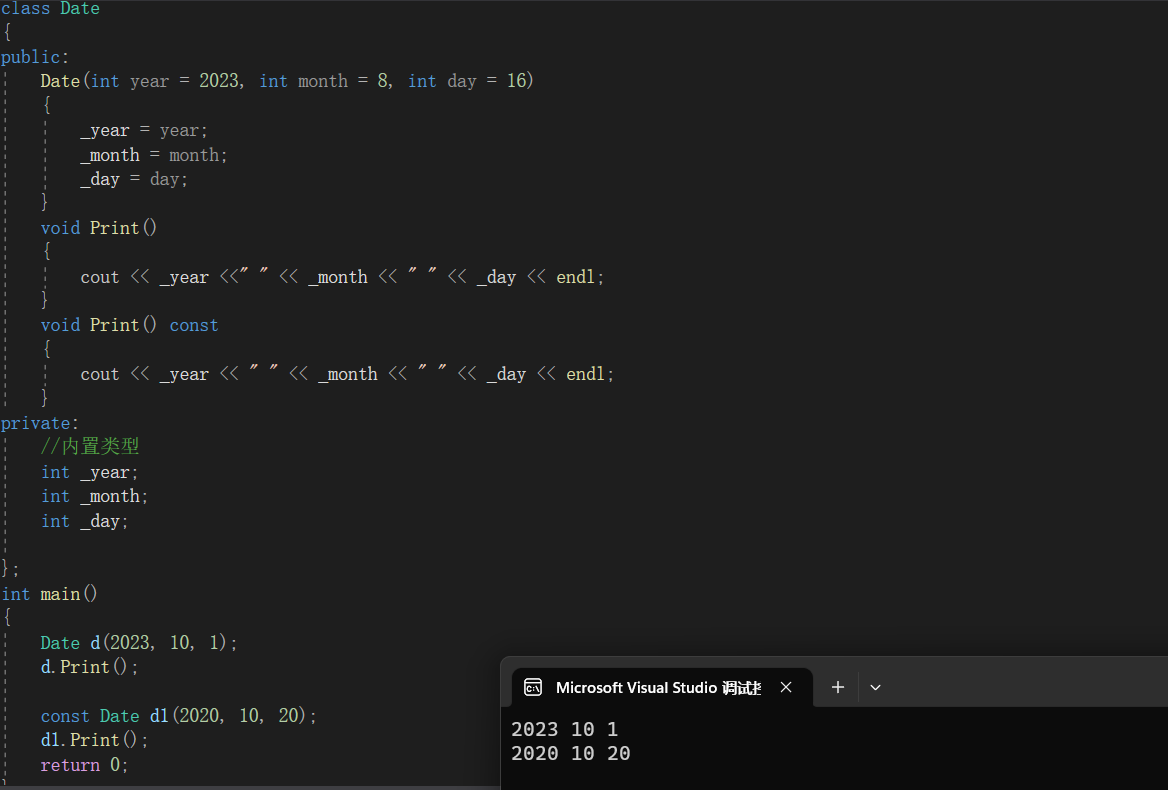
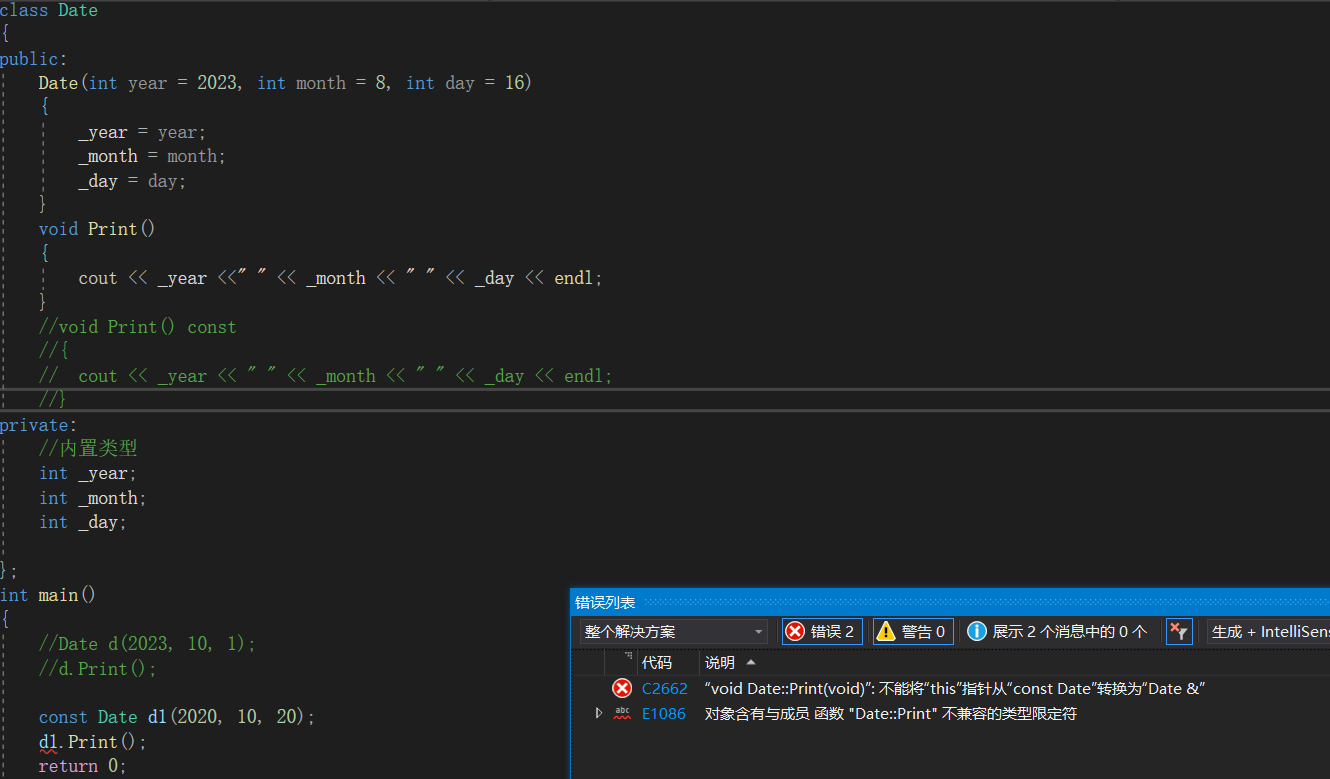
权限可以缩小,可以平移,但不能放大!!!
非const对象可以调用const成员函数
非const成员函数内可以调用其它的const成员函数
反之,不可以。
七:取地址及const取地址操作符重载
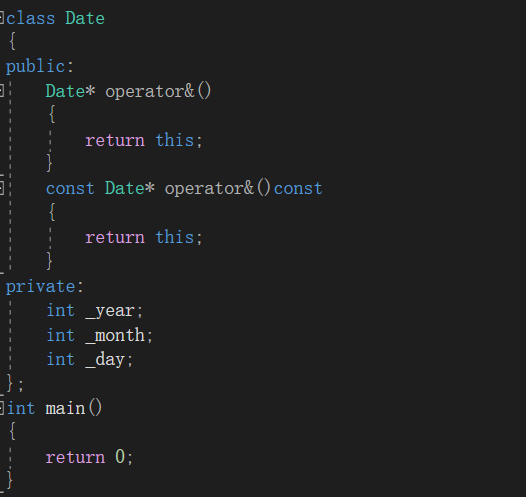
























 被折叠的 条评论
为什么被折叠?
被折叠的 条评论
为什么被折叠?








